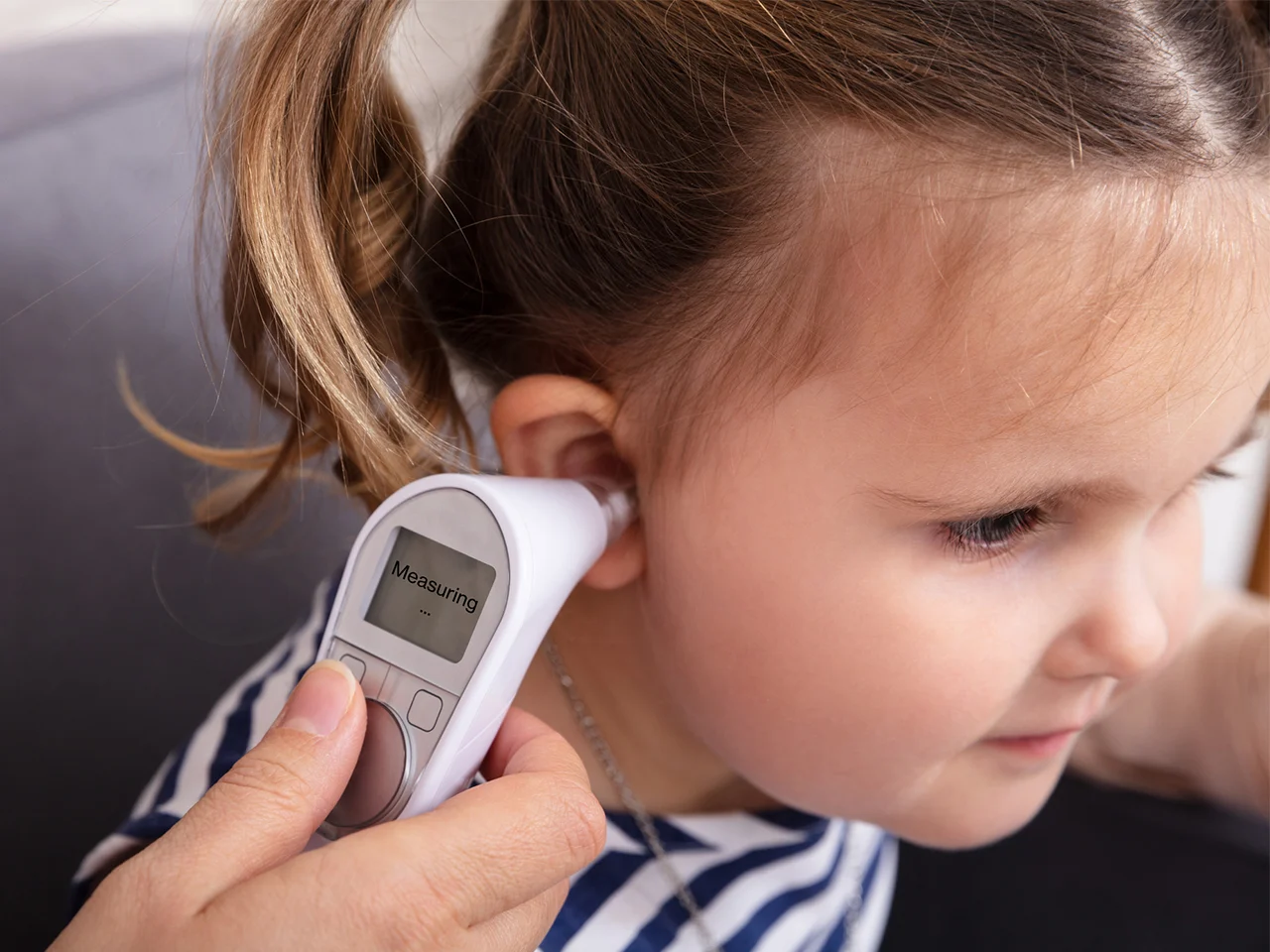Home>Health & Nutrition>Understanding Uneven Ear Temperatures: Causes And Concerns


Health & Nutrition
Understanding Uneven Ear Temperatures: Causes And Concerns
Published: February 19, 2024
Learn about the causes and concerns of uneven ear temperatures and how it relates to health and nutrition. Understand the implications and take necessary steps for a balanced well-being.
(Many of the links in this article redirect to a specific reviewed product. Your purchase of these products through affiliate links helps to generate commission for Temperatures.com, at no extra cost. Learn more)
Table of Contents
Introduction
The human body is a marvel of intricate systems working in harmony to maintain optimal health. One of the key indicators of well-being is body temperature, which can be measured in various ways, including the use of ear thermometers. While a balanced and consistent ear temperature is typically a sign of good health, fluctuations or uneven temperatures between the ears can raise concerns and prompt further investigation.
Understanding the significance of ear temperatures and the potential implications of uneven readings is essential for proactive health management. This article delves into the factors influencing ear temperatures, medical conditions associated with uneven ear temperatures, the importance of monitoring ear temperatures, and when to seek medical attention. By gaining insight into these aspects, individuals can make informed decisions about their health and well-being.
The human ear, with its delicate and intricate structure, plays a crucial role in maintaining equilibrium and facilitating the sense of hearing. The ear canal, in particular, is lined with skin and is in close proximity to the eardrum, making it an ideal site for temperature measurement. Ear thermometers are designed to capture the infrared heat emitted by the eardrum and surrounding tissues, providing a quick and reliable assessment of body temperature.
As with any form of temperature measurement, various factors can influence ear temperature readings. External influences such as ambient temperature, humidity, and the presence of earwax can impact the accuracy of ear thermometer readings. Additionally, individual variations in ear canal size and shape can affect the consistency of measurements between the ears.
Uneven ear temperatures, where one ear registers a different temperature from the other, can be a cause for concern. While minor discrepancies may be attributed to external factors or normal physiological variations, persistent or significant differences between ear temperatures warrant attention. Such variations may indicate an underlying medical condition or systemic imbalance that requires further evaluation.
By exploring the complexities of ear temperatures and their implications, individuals can gain a deeper understanding of this vital aspect of health monitoring. This knowledge empowers individuals to take proactive measures in safeguarding their well-being and seeking appropriate medical guidance when necessary.
Read more: Understanding Fever: Causes And Symptoms
Factors Affecting Ear Temperatures
The accuracy of ear temperature measurements can be influenced by a myriad of factors, ranging from external environmental conditions to individual anatomical variations. Understanding these factors is crucial in interpreting ear temperature readings effectively.
-
External Environment: Ambient temperature and humidity can impact ear temperature measurements. Exposure to extreme temperatures, whether hot or cold, can temporarily affect the ear canal's temperature, leading to inaccurate readings. Similarly, high humidity levels may interfere with the heat exchange process within the ear, affecting the reliability of temperature measurements.
-
Earwax Buildup: The presence of earwax, medically known as cerumen, can obstruct the ear canal and interfere with the accuracy of ear temperature readings. Earwax acts as an insulator, trapping heat and potentially leading to higher temperature readings. Regular ear hygiene practices can help mitigate this factor and improve the precision of ear temperature measurements.
-
Ear Canal Variations: Variations in the size and shape of the ear canal can impact the consistency of ear temperature readings. Individuals with narrow or curved ear canals may experience challenges in obtaining accurate measurements, as the positioning of the thermometer probe can be affected by anatomical differences. Understanding one's unique ear canal anatomy can aid in optimizing the reliability of ear temperature assessments.
-
Influence of Physical Activity: Engaging in physical activities, particularly those that induce perspiration, can transiently elevate ear temperatures. The body's thermoregulatory mechanisms respond to physical exertion by increasing heat production, which can manifest as higher ear temperature readings. It is advisable to allow the body to cool down after physical activity before measuring ear temperatures for accurate results.
-
Age and Developmental Factors: Age-related variations in ear anatomy and thermoregulation can impact temperature measurements. In infants and young children, the ear canal may be smaller and less developed, potentially affecting the positioning and accuracy of ear thermometer readings. Understanding age-specific considerations is essential for obtaining reliable ear temperature assessments in pediatric populations.
By acknowledging and accounting for these factors, individuals can optimize the accuracy of ear temperature measurements, thereby facilitating more informed health monitoring and decision-making. Additionally, healthcare professionals can utilize this knowledge to guide patients in obtaining reliable ear temperature readings and interpreting them within the appropriate context.
Medical Conditions Associated with Uneven Ear Temperatures
Uneven ear temperatures, where one ear registers a different temperature from the other, can be indicative of underlying medical conditions that warrant attention and further evaluation. While minor discrepancies in ear temperatures can be attributed to external factors or normal physiological variations, persistent or significant differences between ear temperatures may signal potential health concerns. Understanding the medical conditions associated with uneven ear temperatures is crucial for recognizing warning signs and seeking appropriate medical guidance.
-
Ear Infections: Inflammation and infection of the ear, such as otitis media or otitis externa, can lead to variations in ear temperatures. The affected ear may exhibit higher temperatures due to the inflammatory response and increased blood flow in the region. Monitoring for additional symptoms such as ear pain, discharge, or hearing difficulties can provide valuable insights into the presence of an ear infection.
-
Eustachian Tube Dysfunction: Dysfunction of the Eustachian tube, which regulates pressure in the middle ear, can contribute to uneven ear temperatures. This condition may result in unequal pressure between the ears, leading to temperature differentials. Individuals experiencing symptoms such as ear fullness, popping sensations, or hearing fluctuations should consider consulting a healthcare professional for further assessment.
-
Inner Ear Disorders: Conditions affecting the inner ear, including vestibular disorders or Meniere's disease, can manifest as variations in ear temperatures. These disorders may disrupt the normal thermoregulation within the ear, leading to temperature imbalances. Accompanying symptoms such as dizziness, vertigo, or tinnitus can provide valuable diagnostic clues in such cases.
-
Systemic Infections: Systemic infections, such as influenza or other viral illnesses, can impact body temperature regulation, potentially resulting in uneven ear temperatures. Monitoring for systemic symptoms, including fever, malaise, and respiratory issues, can aid in identifying the presence of an underlying infection.
-
Neurological Conditions: Certain neurological conditions, such as trigeminal neuralgia or facial nerve disorders, can influence ear temperatures due to their impact on nerve function and sensory perception. Individuals experiencing abnormal sensations in the face or changes in facial muscle function alongside uneven ear temperatures should seek medical evaluation.
By recognizing the potential medical conditions associated with uneven ear temperatures, individuals can be proactive in monitoring their health and seeking appropriate medical attention when necessary. It is important to emphasize that while uneven ear temperatures can serve as indicators of underlying conditions, a comprehensive medical assessment by a qualified healthcare professional is essential for accurate diagnosis and management.
Importance of Monitoring Ear Temperatures
Monitoring ear temperatures holds significant value in proactive health management and early detection of potential health concerns. Ear thermometers provide a convenient and non-invasive method for assessing body temperature, offering several advantages in the realm of health monitoring.
Early Detection of Fever
Ear temperature measurements serve as a reliable indicator of body temperature, allowing individuals to promptly identify fever, a common symptom of various infections and illnesses. Fever often precedes other noticeable symptoms, serving as an early warning sign of potential health issues. By monitoring ear temperatures, individuals can detect fever at its onset, enabling timely intervention and medical evaluation.
Pediatric Health Monitoring
In pediatric care, monitoring ear temperatures is particularly crucial due to the prevalence of childhood illnesses and the challenges associated with traditional temperature measurement methods. Ear thermometers offer a quick and comfortable solution for assessing the temperature of infants and young children, facilitating regular monitoring and early detection of fever-related conditions.
Enhanced Comfort and Accessibility
The non-invasive nature of ear temperature measurements enhances comfort, especially for individuals who may be sensitive to traditional methods such as oral or rectal thermometry. This accessibility encourages regular temperature monitoring, contributing to a proactive approach to health maintenance and illness prevention.
Tracking Temperature Trends
Consistent monitoring of ear temperatures allows individuals to track temperature trends over time, providing valuable insights into the progression of illnesses, response to treatments, and overall health status. By establishing baseline temperature ranges and identifying deviations, individuals can make informed decisions regarding their health and seek appropriate medical attention when necessary.
Facilitating Remote Health Monitoring
In an era of telemedicine and remote healthcare, ear thermometers offer a practical tool for individuals to monitor their health from the comfort of their homes. Remote health monitoring, particularly for individuals with chronic conditions or those at risk of infections, can be significantly enhanced through regular ear temperature assessments.
By recognizing the importance of monitoring ear temperatures, individuals can proactively engage in health maintenance and early intervention, contributing to overall well-being and timely medical management when needed. This proactive approach empowers individuals to take charge of their health and seek appropriate guidance from healthcare professionals, ultimately fostering a culture of preventive healthcare and well-informed health decisions.
When to Seek Medical Attention
Recognizing the appropriate circumstances that warrant seeking medical attention based on ear temperature readings is vital for proactive health management. While minor fluctuations in ear temperatures can often be attributed to benign factors, certain scenarios necessitate prompt medical evaluation to address potential underlying health concerns.
Persistent or Significant Temperature Variances
Persistent and significant differences in ear temperatures between the ears, especially when accompanied by other symptoms such as ear pain, discharge, or changes in hearing, should prompt immediate medical attention. Such variations may indicate underlying conditions such as ear infections, Eustachian tube dysfunction, or inner ear disorders, which require professional assessment and targeted treatment.
Sudden Onset of High Fever
The sudden onset of high fever, as indicated by elevated ear temperatures, particularly in pediatric populations or individuals with compromised immune systems, warrants urgent medical attention. High fever can be a sign of systemic infections or other serious health conditions that require prompt intervention and medical management.
Prolonged or Recurrent Fever
Prolonged or recurrent episodes of fever, reflected in consistent elevations in ear temperatures over an extended period, should not be overlooked. Such patterns may signify underlying health issues that necessitate thorough medical evaluation to identify the root cause and implement appropriate treatment measures.
Presence of Additional Symptoms
When uneven ear temperatures are accompanied by additional symptoms such as dizziness, vertigo, facial muscle weakness, or neurological disturbances, seeking medical attention is imperative. These associated symptoms may indicate underlying neurological or vestibular disorders that require specialized assessment and intervention by healthcare professionals.
Concerns in Pediatric Populations
In pediatric care, any deviations in ear temperatures, particularly in infants and young children, should be closely monitored. Persistent or unexplained variations in ear temperatures, especially when accompanied by changes in behavior, feeding difficulties, or irritability, should prompt immediate medical consultation to ensure comprehensive evaluation and appropriate management.
Individual Health History and Risk Factors
Individuals with pre-existing health conditions, compromised immune systems, or a history of recurrent ear-related issues should be vigilant in monitoring ear temperatures. Any deviations from baseline readings or concerns regarding temperature differentials should be promptly discussed with healthcare providers to address potential health implications.
By recognizing these indicators and being proactive in seeking medical attention when necessary, individuals can prioritize their health and well-being, facilitating early intervention and appropriate management of potential health concerns. Timely medical assessment and guidance play a pivotal role in addressing underlying conditions, promoting recovery, and ensuring optimal health outcomes.
Conclusion
In conclusion, understanding the nuances of ear temperatures and their implications is pivotal for proactive health management and early detection of potential health concerns. The intricate interplay of factors influencing ear temperature measurements, including external environmental influences, anatomical variations, and developmental considerations, underscores the importance of interpreting ear temperatures within the appropriate context. While minor discrepancies in ear temperatures can often be attributed to benign factors, persistent or significant variations between the ears may serve as indicators of underlying medical conditions that warrant attention and further evaluation.
The significance of monitoring ear temperatures extends beyond mere temperature assessment, encompassing early detection of fever, pediatric health monitoring, enhanced comfort and accessibility, tracking temperature trends, and facilitating remote health monitoring. By leveraging the advantages of ear thermometers, individuals can proactively engage in health maintenance, illness prevention, and timely medical intervention when necessary. This proactive approach empowers individuals to take charge of their health and seek appropriate guidance from healthcare professionals, ultimately fostering a culture of preventive healthcare and well-informed health decisions.
Recognizing the appropriate circumstances that warrant seeking medical attention based on ear temperature readings is crucial for timely intervention and targeted management of potential health concerns. Persistent or significant temperature variances, sudden onset of high fever, prolonged or recurrent fever, presence of additional symptoms, concerns in pediatric populations, and individual health history and risk factors serve as key indicators for prompt medical evaluation and intervention. By being vigilant and proactive in seeking medical attention when necessary, individuals can prioritize their health and well-being, facilitating early intervention and appropriate management of potential health concerns.
In essence, the comprehensive understanding of ear temperatures, the factors influencing them, the medical conditions associated with uneven ear temperatures, the importance of monitoring ear temperatures, and the appropriate circumstances for seeking medical attention collectively contribute to informed health decisions and proactive health management. By integrating this knowledge into daily health practices, individuals can optimize their well-being, promote early detection of potential health issues, and collaborate effectively with healthcare professionals to ensure optimal health outcomes.












